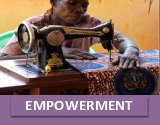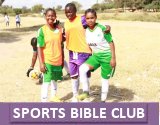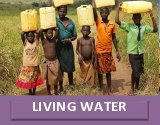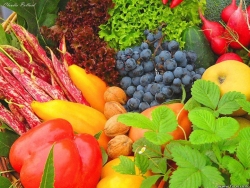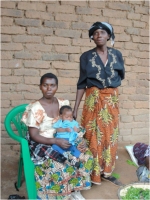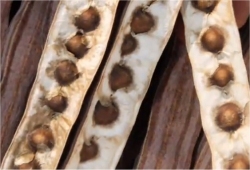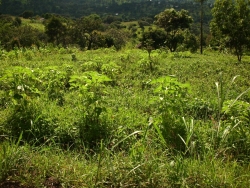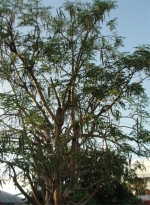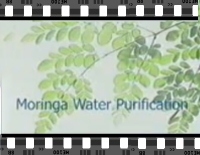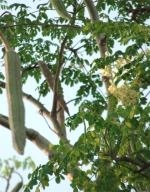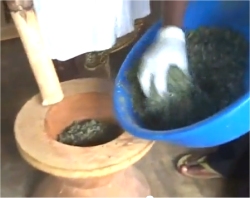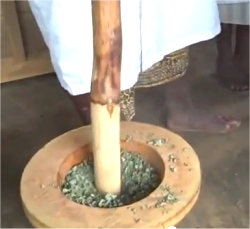Stonecroft
Mafunzo wa Stonecroft
Mfululizo wa Utatu wa Stonecroft
Kitabu cha Mwongozo
Mistari ya Biblia
Stonecroft Kimataifa
The International Team
Uinjilisti wa Mtoto
Mradi wa Mlonge
Mtaala wa UCT

|
|
home >>stonecroft
>> tanzania
after school club >> moringa
Tanzania
Child Sponsorship Program
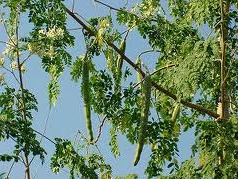
|
Moringa is one the greatest gifts which
Nature bestowed on man - this was known to the ancient world
and they regarded the tree as a “Cure-all Tree”.
They also saw the Moringa tree as an “Elixir of long
life”, “the Tree of Immortality”, “the
Tree of Life”, “the Never Die Tree”, “the
Miracle Tree" and “Mother’s best friend”.
|
Nutritional analysis has shown
that Moringa leaves are extremely nutritious especially when dried.
There is a massive increase in vitamin content in the dried leaves
compared to fresh green leaves except for vitamin C. (In green leaves
there is 7 times more Vitamin C than in oranges.)
In dried leaves there are:
- 17 times more Calcium in dry Moringa leaves than
in milk
- 10 times more Vitamin A in dry Moringa leaves
than in carrots
- 15 times more Potassium in dry Moringa leaves
than in bananas
- 25 times more iron in dry Moringa leaves than
in spinach
- 9 times the protein in dry Moringa leaves than
in milk
|
|
 |
Another important point is that Moringa
leaves contain all of the essential amino acids, which are
the building blocks of proteins. It is very rare for a vegetable
to contain all of these amino acids.
Moringa leaves could be a great benefit
to the Haitians who do not get a lot of protein from meat.
|
|
Experts tell us that over 30% of children in Africa are protein
deficient.
Kwashiorkor is a severe protein deficiency,
a malnourishment that kills many African children before their
fifth birthday.
Just one teaspoon of dried Moringa Leaf Meal
(powder) three times a day can prevent and treat Kwashiorkor
and save the lives of children in Tanzania.
|
|
| UCT Tanzania
Moringa Pilot Project:
Moringa seeds were sourced in Africa and were
soaked overnight prior to planting.
|
|
| 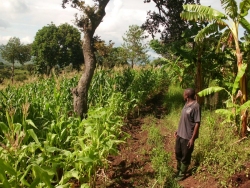
|
The deposit on
the new UCT Tanzania land has been paid and we are excited
about aquiring this 10 acre plot of rich fertile land for
our Moringa project. |

|
Thousands of Moringa will be planted in
Mbeya
|
Initally Moringa will
be used as Living Fencing around the land, they were planted
at 1 meter intervals and wire is to used between the trees once
they become more established
|
|
Moringa trees can also be planted
very close together as a field crop, at a spacing as close
as ten centimeters.
When planted as a field crop Moringa can be
harvested frequently. This technique produces a large amount
of usable green matter from a relatively small amount of space.
|
|
| 
|
Moringa can be grown intensively with no
irrigation and small amounts of fertilizer. It thrives well
in dry, poor, sandy soil and is very drought tolerant making
it ideally suitable for the arid areas in Haiti where other
crops do not survive.
|
|
If the Moringa plantation is irrigated and
fertilized harvesting can be achieved every 35 days—ten
crops per year—with a total yield of 650 tons of green
matter per hectare.The plants are harvested 10 cm above the
base, and all of the leaves and green shoots can be used.
This yield can be consistent from the same plants for seven
years. This can meet the Vitamin A needs of 15,000 children!
|
|
| 
|
Using this technique of intensive cultivation,
plots of Moringa can be planted on a rotation schedule,
so that there is an ongoing supply of green matter.
|
|

|
Moringa can be planted 1 meters apart, in
rows that are at least 2 meters apart, for easy weed removal
and walking through the rows. This will allow the Moringa
to grow tall and mature.
These mature Moringa can provide
pods for eating and seeds for propagation or the production
of BenOil.
|
Moringa has been used for thousands of years by
Africans and Indians to treat over 300 different diseases and ailments.
It is a sustainable food source for third world countries where
malnutrition is prevalent and UCT is excited about the potential
of introducing it as part of our Haiti and Africa child sponsorship
feeding program.
| Regular
use of Moringa can:
- lowers blood pressure
- enhance a feeling of well being
- treat stomach disorders.
- healthier bones, skin, teeth and nails
- treat diarrhea
- a stronger immune system
- boosts energy levels
- reduces blood sugar
- reduces osteoporosis
- plus more!
|

|
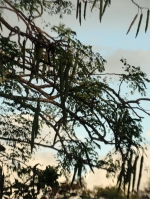 |
HOW TO USE THE LEAVES:
• Add fresh leaf or dry leaf powder
to dishes like salads and soups.
• Brew delicious tea with Moringa Tea Leaf Powder.
• Add Moringa Leaf Powder to your favorite dip or
sauce to give it a nutritional boost.
• Use natural and body-friendly cosmetic products
like:
a.The Moringa Facial Mask.
b.Moringa Deodorant, Moringa Lip Balm and Moringa soap.
c.Moringa Oil is good for the body, inside and out!
|
| HOW TO
USE THE SEEDS:
Moringa seeds contain oil that can be used
for cooking. It has a pleasant nutty taste, and never goes
rancid and is used in fine machinery. BenOil burns clean and
so is a good source for heat and light
|
|
The seed cake left over after extracting oil can
be used as a protein-rich plant fertilizer and can also be used
for water purification.
An age-old method 'Purifying Water With Moringa'
Oleifera seeds is demonstrated in this YouTube video.
CLICK
to view.
MORINGA AS ANIMAL
FODDER:
Moringa leaves will be fed to the chickens, pigs,
cattle and rabbits . Leaves can also be used as food for the Tilapia
fish in the UCT Aquaponic Program..
 |
Poultry production plays a major role in
bridging the protein gap in developing countries where average
daily consumption is far below recommended standards.
However, the productivity of poultry in
the tropics has been limited by scarcity and consequent
high prices of the conventional chicken food.
|
Moringa leaf meals do not only serve as protein source but also
provide some necessary vitamins, minerals and oxycaretenoids which
cause yellow colour of broiler skin, shank and egg yolk. Feeding
chickens with Moringa leaves and seeds will improve egg production.
The inclusion of Moringa Oleifera Leaf Meal up to 30% in the diet
of chickens had no negative impact on body weight, health and mortality
rate in birds.
Considering the high price of commercial poultry food the inclusion
of Moringa and other leguminous leaves in the diets of chickens,
such as Mulberry, is a real opportunity for chicken farmers to improve
not only the productivity and nutritional status of their birds
but also their income with a 50% saving.
| Fattening pigs on 50% Moringa stems
and leaves, 10% Leucaena, 38% Mulberry and 2% nutrient salts
will lead to good growth rates and significant cost savings. |
|
 |
• Moringa Oleifera Leaf Meal (MOLM) could be used
to improve daily weight gain in rabbits.
• Producing similar economic benefits as Soya Bean
Meal (SBM) diet.
• MOLM is non-toxic to rabbits at least at the 20%
diet inclusion level.
• It has the potential to reduce cholesterol level
in blood and the meat of rabbits.
|
| STEP 1- Harvesting:
Within less than six months our 300 special
Moringa plants will be ready for the first harvest.
|
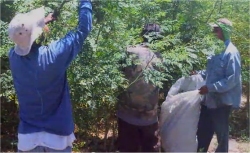
|

 |
-
The Moringa leaves will
be transported to the Processing Plant where they are
first washed in large buckets or pots in well or catchment
water.
- The second wash is done in clean water.
Photographs compliments of Shape
Lives Foundation
|
|
Step 3 - Picking:
Hats, masks, gloves and over coats are worn
to comply with good food hygiene standards.
The washed Moringa leaves are then removed
from the twigs. (These can be chopped into 10cm pieces and
fed to sheep and goats)
Once removed the washed leaves are collected
and placed in a large bowl.
Photographs compliments of Shape
Lives Foundation |
|
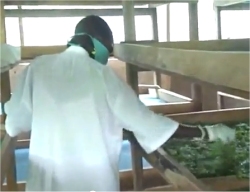
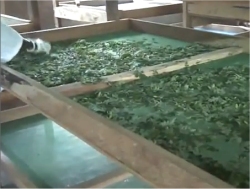
|
Step 4 - Drying:
The leaves are now placed in the drying
trays in the shade for 2 - 3 days.
The leaves are shifted around a few times
per day to ensure a circulation of air.
The drying area must be rodent free and
out of direct sunlight which will destroy the Vitamin A
content.
Photographs compliments of Shape
Lives Foundation
|
|
Step 5 - Pounding:
The dried Moringa leaves are then pounded
using a Mortar Pestle before packaging.
Photographs compliments of Shape
Lives Foundation |
|
| 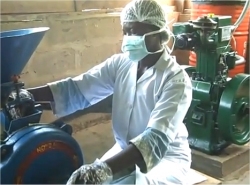
|
Step 6 - Grinding:
After the
pounding the leaves can be passed through a grinding machine
but at the moment UCT is not able to purchase a grinder.
Approximately US $15,000 would be needed to
set up this next stage of production.
Photographs compliments of Shape
Lives Foundation |
Step 7- Sieving
After the grinding the leaves will be sieved
to produce the powder.
Photographs
compliments of Shape
Lives Foundation |
|


|
Step 8 - Weighing, packaging
and sealing:
These Moringa Leaf Packs will be initially
used within our After School Clubs where we will feed the
children physical and Spiritual.
Eventually once we are equipped with the
grinding machine UCT will be capable of producing Moringa
Oleifera Leaf Meal (MOLM) or powdered Moringa leaves.
These packs will be exported to the American
Health Market to generate revenue for the ministry and sold
online on www.moringaonlinestore.com.
A commercial website being prepared in readiness
for this Internet business.
Photographs compliments of Shape
Lives Foundation
|
|
|

